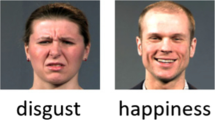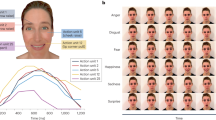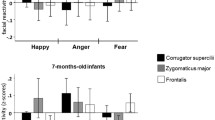Abstract
The specificity of facial processing impairment in autistic children, particularly in the domain of emotion, is still debated. The aim of our study was to assess the influence of motion on facial expression recognition in young autistic children. Thirteen autistic children (M age: 69.38 months) were matched for gender and developmental level with a control group of 13 normal children (M age: 40.53 months). They were compared on their ability to match videotaped “still,” “dynamic,” and “strobe” emotional and nonemotional facial expressions with photographs. Results indicate that children with autism do not perform significantly worse than their controls in any of our experimental conditions. Compared to previous studies showing lower performance in autistic than in control children when presented with static faces, our data suggest that slow dynamic presentations facilitate facial expression recognition by autistic children. This result could be of interest to parents and specialists involved in education and reeducation of these children.
Similar content being viewed by others
REFERENCES
American Psychiatric Association. (1994). Diagnostic and statistical manual of mental disorders(4th ed.) Washington DC: Author.
Baron-Cohen, S. (1994). How to build a baby that can read minds: Cognitive mechanisms in mindreading. Current Psychology of Cognition, 13513-552.
Baron-Cohen, S., Campbell, R., Karmiloff-Smith, A., & Grant, J. (1995). Are children with autism blind to the mentalistic significance of the eyes? British Journal of Developmental Psychology, 13379-398.
Berry D. S. (1990). What can a moving face tell us? Journal of Personality and Social Psychology, 371004-1014.
Boucher, J., Lewis, V., & Collis, G. (1998). Familiar face and voice matching and recognition in children with autism. Journal of Child Psychology and Psychiatry, 39171-181.
Braverman, M., Fein, D., Lucci, D., & Waterhouse, L. (1989). Affect comprehension in children with pervasive developmental disorders. Journal of Autism and Developmental Disorders, 19301-316.
Brunet-Lezine, O. (1951). Echelle de développement psychomoteur de la première enfance. In Le Développement Psychologique de la Première Enfance.P.U.F.
Campbell, R., Brooks, B., de Haan, E. & Roberts, T. (1996). Dissociating face processing skills: Decision about lipread speech, expression, and identity. Quarterly Journal of Psychology, 49295-314.
Campbell, R., Landis, T., & Regard, M. (1986). Face recognition and lipreading. Brain, 109509-521.
Celani, G., Battacchi, M. W., & Arcidiacono, L. (1999). The understanding of the emotional meaning of facial expressions in people with autism. Journal of Autism and Developmental Disorders, 2957-66.
Corona, R., Dissanayake, C., Arbelle, S., Wellington, P., & Sigman, M. (1998). Is affect aversive to young children with autism? Behavioral and cardiac responses to experimenter distress. Child Development, 691494-1502.
Davies, S., Bishop, D., Manstead, A. S. R., & Tantam, D. (1994). Face perception in children with autism and Asperger's syndrome. Journal of Child Psychology and Psychiatry, 351033-1057.
Frankel, F., Simmons, J. Q., Fichter, M., & Freeman, B. J. (1984). Stimulus overselectivity in autistic and mentally retarded children: A research note. Journal of Child Psychology and Psychiatry, 25147-155.
Frith, U. (1989). Autism: Explaining the enigma.Oxford, Balckwell.
de Gelder, B., Vroomen, J., & van Der Heide, L. (1991). Face recognition and lip-reading in autism. European Journal of Cognitive Psychology, 369-86.
Gepner, B. (1999). Vision du mouvement et développement: Conséquences pour la compréhension des troubles autistiques. Bulletin Scientifique de l'ARAPI, 331-37.
Gepner, B., de Gelder, B., & de Schonen, S. (1996). Face processing in autistics: Evidence for a generalized deficit? Child Neuropsychology, 2123-139.
Gepner, B., de Schonen, S., & Buttin, C. (1994). Face processing in young autistic children. Infant Behavior and Development, 17661.
Gepner, B., Mestre, D., Masson, G., & de Schonen, S. (1995). Postural effects of motion vision in young autistic children. NeuroReport, 61211-1214.
Grandin, T. (1995). Thinking in pictures and other reports from my life with autism.New York, Doubleday.
Harwood, N. K., Hall, L. J., & Shinkfield, A. J. (1999). Recognition of facial emotional expressions from moving and static displays by individuals with mental retardation. American Journal on Mental Retardation, 104270-278.
Hobson, R. P. (1986a). The autistic child's appraisal of expressions of emotion: A further study. Journal of Child Psychology and Psychiatry, 27671-680.
Hobson, R. P. (1986b). The autistic child's appraisal of expressions of emotion. Journal of Child Psychology and Psychiatry, 27321-342.
Hobson, R. P. (1989). Beyond cognition: A theory of autism. In G. Dawson (Ed.), Autism: New perspectives on diagnosis, nature and treatment.New York: Guilford.
Hobson, R. P., Ouston, J., & Lee, A. (1988a). Emotion recognition in autism: Coordinating faces and voices. Psychological Medecine, 18911-923.
Hobson, R. P., Ouston, J., & Lee, A. (1988b). What's in a face? The case of autism. British Journal of Psychology, 79441-453.
Humphrey, G. W., Donnelly, N., & Riddoch, M. J. (1993). Expression is computed separately from facial identity, and is computed separately for moving and static faces: Neuropsychological evidence. Neuropsychologia, 31173-181.
Hutt, C., & Ounsted, C. (1966). The biological significance of gaze avoidance with particular reference to the syndrome of infantile autism. Behavioral Sciences, 11346-356.
Kanner, L., (1943). Autistic disturbances of affective contact. Nervous Child, 2217-250.
Lovaas, O. I., & Schreibman, L. (1971). Stimulus overselectivity of autistic children in two stimulus situation. Behavioral Research and Therapy, 9305-310.
Loveland, K. A., Tunali-Kotoski, B., Chen, R., Brelsford, K. A., Ortegon, J. & Pearson, D. A. (1995). Intermodal perception of affect in persons with autism or Down syndrome. Development and Psychopathology, 7409-418.
Loveland, K. A., Tunali-Kotoski, B., Chen, R., Ortegon, J., Pearson, D. A., Brelsford, K. A., & Gibbs, M. C. (1997). Emotion recognition in autism: Verbal and nonverbal information. Developmental Psychopathology, 9579-593.
McCarthy, D. (1972). Manual for the McCarthy Scales of Children Abilities (MSCA).New York: Psychological Corp.
Mundy, P., Sigman, M. & Kasari, C. (1990). A longitudinal study of joint attention and language development in autistic children. Journal of Autism and Developmental Disorders, 20115-128.
Nadel, J. (1989). Communicating by imitation: A developmental and comparative approach to transitory social competence. In B. H. Schneider et al.(Eds.), Social competence in developmental perspective(pp. 131-144). Dordrecht, The Netherlands: Kluwer Academic Publishers.
Nelson, C. A., & Horowitz, F. D. (1987). Visual motion perception in infancy. In T. M. Field & N. A. Fox (Eds.), Social perception in infants(pp. 101-125). Norwood, NJ: Ablex.
Ozonoff, S., Pennington, B. F., & Rogers, S. J. (1990). Are there emotion perception deficits in young autistic children? Journal of Child Psychology and Psychiatry, 31343-361.
Pacteau, C., Bonthoux, F., Perruchet, P., & Lautrey, J. (1994). Category learning of schematic faces in children: Relationships between attribute knowledge and modes of processing. Cahiers de Psychologie Cognitive, 13797-820.
Schopler, E., Reichler, R. J., DeVellis, R. F., & Daly, K. (1980). Toward objective classification of childhood autism: Childhood autism rating scale (CARS). Journal of Autism and Developmental Disorders, 1091-103.
Soken, N. H., & Pick, A. D. (1992). Intermodal perception of happy and angry expressive behaviors by seven-month-old infants. Child Development, 63787-795.
Tantam, D., Monaghan, L., Nicholson, H. & Stirling J. (1989). Autistic children's ability to interpret faces: a research note. Journal of Child Psychology and Psychiatry, 30623-630.
Tada, W. L., & Stiles, J. (1996). Developmental change in children's analysis of spatial patterns. Developmental Psychology, 32951-970.
Thompson, L. A., & Massaro, D. W. (1989). Before you see it, you see its parts: Evidence for feature encoding and integration in preschool children and adults. Cognitive Psychology, 21334-362.
Waterhouse, L., Fein, D., & Modahl, C. (1996). Neurofunctional mechanisms in autism. Psychological Review, 103457-489.
Weeks, S. J., & Hobson, R. P. (1987). The salience of facial expression for autistic children. Journal of Child Psychology and Psychiatry, 28137-152.
Williams, D. (1992). Nobody nowhere.London, Doubleday.
World Health Organization. (1992). International statistical classification of diseases and related health problems, ICD-10, Chapter V (F00-F99). Geneva: Author.
Author information
Authors and Affiliations
Rights and permissions
About this article
Cite this article
Gepner, B., Deruelle, C. & Grynfeltt, S. Motion and Emotion: A Novel Approach to the Study of Face Processing by Young Autistic Children. J Autism Dev Disord 31, 37–45 (2001). https://doi.org/10.1023/A:1005609629218
Issue Date:
DOI: https://doi.org/10.1023/A:1005609629218




